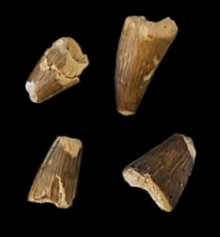| Aigialosuchus Temporal range: Early Campanian
| |
|---|---|

| |
| Teeth attributed to Aigialosuchus sp. found in the Kristianstad Basin | |
| Scientific classification | |
| Domain: | Eukaryota |
| Kingdom: | Animalia |
| Phylum: | Chordata |
| Class: | Reptilia |
| Clade: | Archosauria |
| Clade: | Pseudosuchia |
| Clade: | Crocodylomorpha |
| Clade: | Crocodyliformes |
| Family: | †Dyrosauridae |
| Genus: | †Aigialosuchus Persson, 1959 |
| Species: | †A. villandensis
|
| Binomial name | |
| †Aigialosuchus villandensis Persson, 1959
| |
Aigialosuchus is an extinct genus of long-snouted crocodylomorph that lived in what is now Sweden during the Campanian stage of the Late Cretaceous period. The name Aigialosuchus comes from the Greek αἰγιαλός (aigialos), meaning "seashore", and σοῦχος (souchus), meaning "crocodile". The genus contains a single species, A. villandensis, described in 1959 by Per Ove Persson based on material recovered from the Kristianstad Basin in southern Sweden.
The known fossil material of Aigialosuchus consists of a partial skull and isolated teeth from southern Sweden, with possible additional teeth found on Zealand in Denmark. The fragmentary nature of these remains means that the precise classification of the genus remains uncertain. Though typically classified as an eusuchian, since 2016 it has been repeatedly placed within the more basal family Dyrosauridae.
In the Cretaceous, southern Scandinavia was covered by shallow sea and the Ivö Klack site within the Kristianstad Basin, where most of the fossils referred to Aigialosuchus have been found, was a small and rocky island. Many other dyrosaurids were marine, a lifestyle possibly shared by Aigialosuchus since its fossils have been discovered in marine deposits. Its teeth were short and stout, possibly an adaptation towards feeding on large fish and invertebrates.